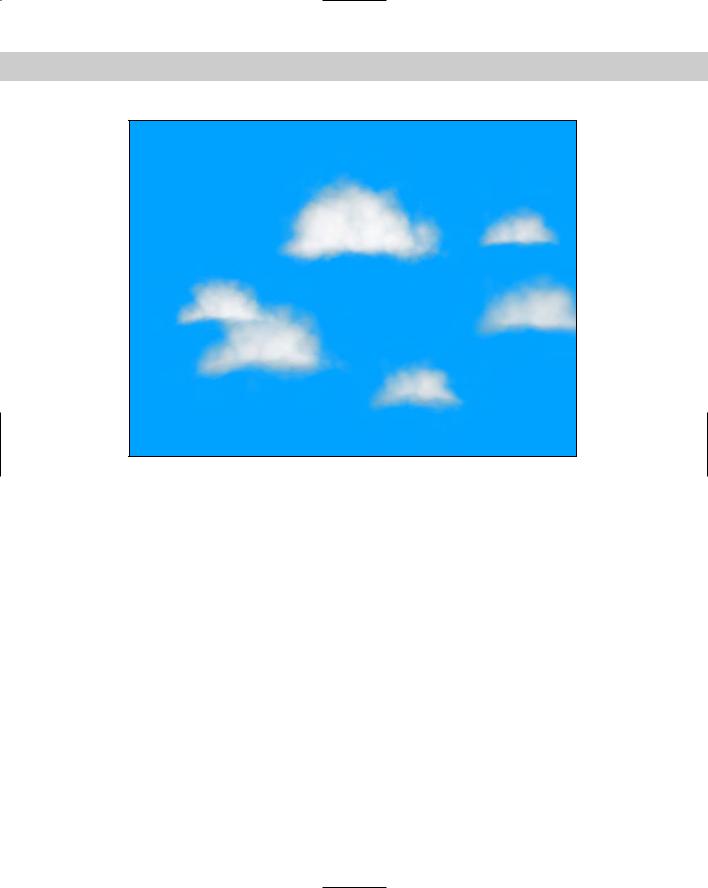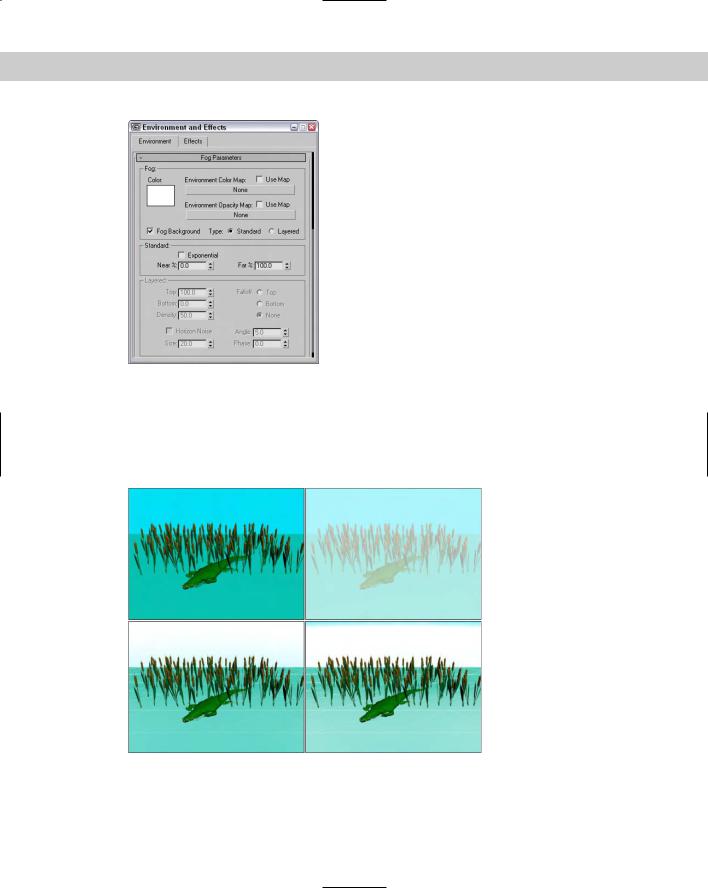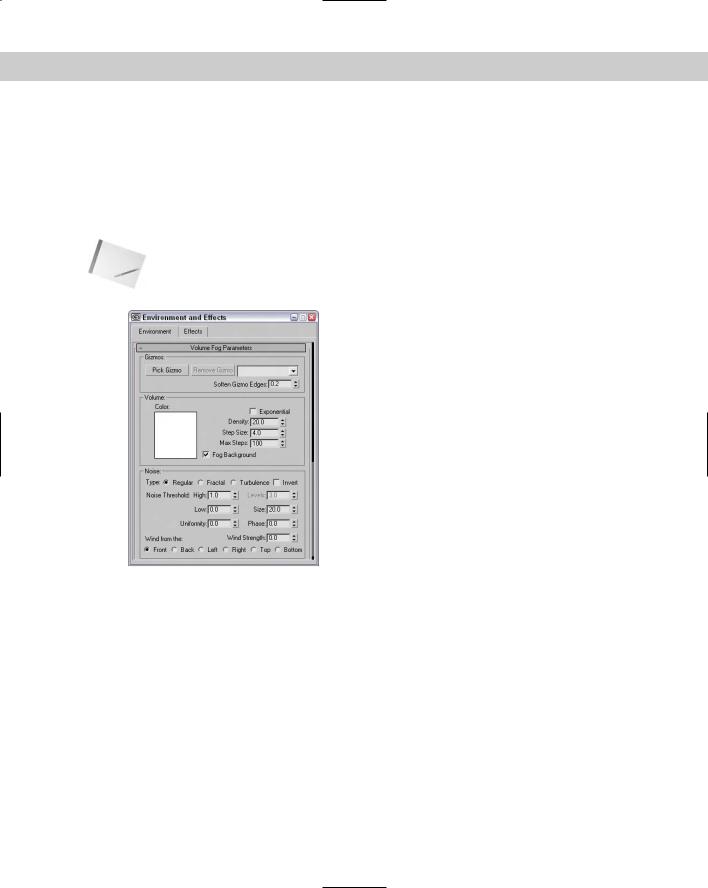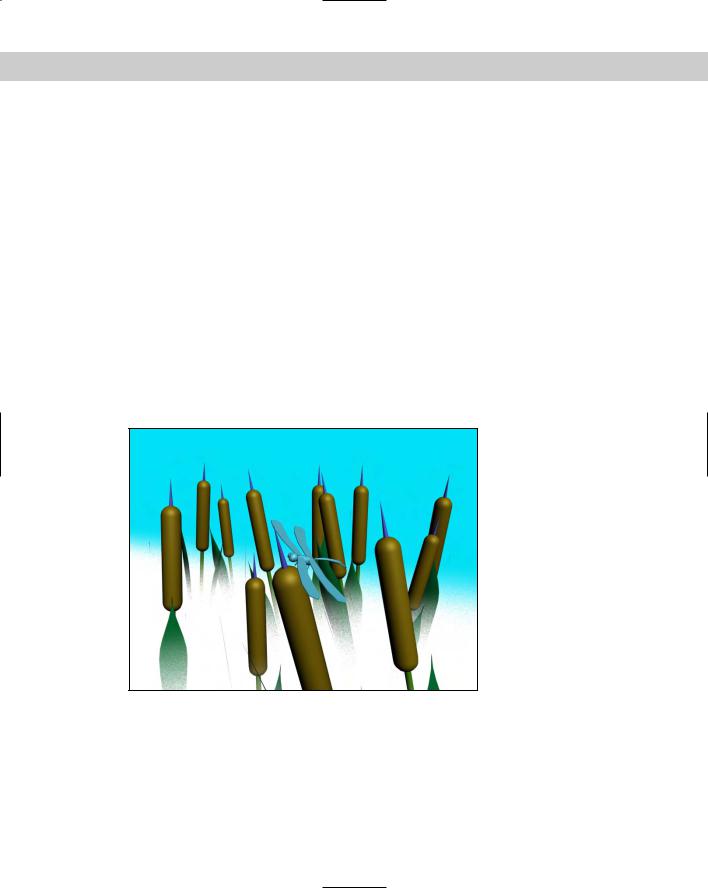
- •Preface
- •About This Book
- •Acknowledgments
- •Contents at a Glance
- •Contents
- •Relaxing at the Beach
- •Dressing the Scene
- •Animating Motion
- •Rendering the Final Animation
- •Summary
- •The Interface Elements
- •Using the Menus
- •Using the Toolbars
- •Using the Viewports
- •Using the Command Panel
- •Using the Lower Interface Bar Controls
- •Interacting with the Interface
- •Getting Help
- •Summary
- •Understanding 3D Space
- •Using the Viewport Navigation Controls
- •Configuring the Viewports
- •Working with Viewport Backgrounds
- •Summary
- •Working with Max Scene Files
- •Setting File Preferences
- •Importing and Exporting
- •Referencing External Objects
- •Using the File Utilities
- •Accessing File Information
- •Summary
- •Customizing Modify and Utility Panel Buttons
- •Working with Custom Interfaces
- •Configuring Paths
- •Selecting System Units
- •Setting Preferences
- •Summary
- •Creating Primitive Objects
- •Exploring the Primitive Object Types
- •Summary
- •Selecting Objects
- •Setting Object Properties
- •Hiding and Freezing Objects
- •Using Layers
- •Summary
- •Cloning Objects
- •Understanding Cloning Options
- •Mirroring Objects
- •Cloning over Time
- •Spacing Cloned Objects
- •Creating Arrays of Objects
- •Summary
- •Working with Groups
- •Building Assemblies
- •Building Links between Objects
- •Displaying Links and Hierarchies
- •Working with Linked Objects
- •Summary
- •Using the Schematic View Window
- •Working with Hierarchies
- •Setting Schematic View Preferences
- •Using List Views
- •Summary
- •Working with the Transformation Tools
- •Using Pivot Points
- •Using the Align Commands
- •Using Grids
- •Using Snap Options
- •Summary
- •Exploring the Modifier Stack
- •Exploring Modifier Types
- •Summary
- •Exploring the Modeling Types
- •Working with Subobjects
- •Modeling Helpers
- •Summary
- •Drawing in 2D
- •Editing Splines
- •Using Spline Modifiers
- •Summary
- •Creating Editable Mesh and Poly Objects
- •Editing Mesh Objects
- •Editing Poly Objects
- •Using Mesh Editing Modifiers
- •Summary
- •Introducing Patch Grids
- •Editing Patches
- •Using Modifiers on Patch Objects
- •Summary
- •Creating NURBS Curves and Surfaces
- •Editing NURBS
- •Working with NURBS
- •Summary
- •Morphing Objects
- •Creating Conform Objects
- •Creating a ShapeMerge Object
- •Creating a Terrain Object
- •Using the Mesher Object
- •Working with BlobMesh Objects
- •Creating a Scatter Object
- •Creating Connect Objects
- •Modeling with Boolean Objects
- •Creating a Loft Object
- •Summary
- •Understanding the Various Particle Systems
- •Creating a Particle System
- •Using the Spray and Snow Particle Systems
- •Using the Super Spray Particle System
- •Using the Blizzard Particle System
- •Using the PArray Particle System
- •Using the PCloud Particle System
- •Using Particle System Maps
- •Controlling Particles with Particle Flow
- •Summary
- •Understanding Material Properties
- •Working with the Material Editor
- •Using the Material/Map Browser
- •Using the Material/Map Navigator
- •Summary
- •Using the Standard Material
- •Using Shading Types
- •Accessing Other Parameters
- •Using External Tools
- •Summary
- •Using Compound Materials
- •Using Raytrace Materials
- •Using the Matte/Shadow Material
- •Using the DirectX 9 Shader
- •Applying Multiple Materials
- •Material Modifiers
- •Summary
- •Understanding Maps
- •Understanding Material Map Types
- •Using the Maps Rollout
- •Using the Map Path Utility
- •Using Map Instances
- •Summary
- •Mapping Modifiers
- •Using the Unwrap UVW modifier
- •Summary
- •Working with Cameras
- •Setting Camera Parameters
- •Summary
- •Using the Camera Tracker Utility
- •Summary
- •Using Multi-Pass Cameras
- •Creating Multi-Pass Camera Effects
- •Summary
- •Understanding the Basics of Lighting
- •Getting to Know the Light Types
- •Creating and Positioning Light Objects
- •Viewing a Scene from a Light
- •Altering Light Parameters
- •Working with Photometric Lights
- •Using the Sunlight and Daylight Systems
- •Using Volume Lights
- •Summary
- •Selecting Advanced Lighting
- •Using Local Advanced Lighting Settings
- •Tutorial: Excluding objects from light tracing
- •Summary
- •Understanding Radiosity
- •Using Local and Global Advanced Lighting Settings
- •Working with Advanced Lighting Materials
- •Using Lighting Analysis
- •Summary
- •Using the Time Controls
- •Working with Keys
- •Using the Track Bar
- •Viewing and Editing Key Values
- •Using the Motion Panel
- •Using Ghosting
- •Animating Objects
- •Working with Previews
- •Wiring Parameters
- •Animation Modifiers
- •Summary
- •Understanding Controller Types
- •Assigning Controllers
- •Setting Default Controllers
- •Examining the Various Controllers
- •Summary
- •Working with Expressions in Spinners
- •Understanding the Expression Controller Interface
- •Understanding Expression Elements
- •Using Expression Controllers
- •Summary
- •Learning the Track View Interface
- •Working with Keys
- •Editing Time
- •Editing Curves
- •Filtering Tracks
- •Working with Controllers
- •Synchronizing to a Sound Track
- •Summary
- •Understanding Your Character
- •Building Bodies
- •Summary
- •Building a Bones System
- •Using the Bone Tools
- •Using the Skin Modifier
- •Summary
- •Creating Characters
- •Working with Characters
- •Using Character Animation Techniques
- •Summary
- •Forward versus Inverse Kinematics
- •Creating an Inverse Kinematics System
- •Using the Various Inverse Kinematics Methods
- •Summary
- •Creating and Binding Space Warps
- •Understanding Space Warp Types
- •Combining Particle Systems with Space Warps
- •Summary
- •Understanding Dynamics
- •Using Dynamic Objects
- •Defining Dynamic Material Properties
- •Using Dynamic Space Warps
- •Using the Dynamics Utility
- •Using the Flex Modifier
- •Summary
- •Using reactor
- •Using reactor Collections
- •Creating reactor Objects
- •Calculating and Previewing a Simulation
- •Constraining Objects
- •reactor Troubleshooting
- •Summary
- •Understanding the Max Renderers
- •Previewing with ActiveShade
- •Render Parameters
- •Rendering Preferences
- •Creating VUE Files
- •Using the Rendered Frame Window
- •Using the RAM Player
- •Reviewing the Render Types
- •Using Command-Line Rendering
- •Creating Panoramic Images
- •Getting Printer Help
- •Creating an Environment
- •Summary
- •Creating Atmospheric Effects
- •Using the Fire Effect
- •Using the Fog Effect
- •Summary
- •Using Render Elements
- •Adding Render Effects
- •Creating Lens Effects
- •Using Other Render Effects
- •Summary
- •Using Raytrace Materials
- •Using a Raytrace Map
- •Enabling mental ray
- •Summary
- •Understanding Network Rendering
- •Network Requirements
- •Setting up a Network Rendering System
- •Starting the Network Rendering System
- •Configuring the Network Manager and Servers
- •Logging Errors
- •Using the Monitor
- •Setting up Batch Rendering
- •Summary
- •Compositing with Photoshop
- •Video Editing with Premiere
- •Video Compositing with After Effects
- •Introducing Combustion
- •Using Other Compositing Solutions
- •Summary
- •Completing Post-Production with the Video Post Interface
- •Working with Sequences
- •Adding and Editing Events
- •Working with Ranges
- •Working with Lens Effects Filters
- •Summary
- •What Is MAXScript?
- •MAXScript Tools
- •Setting MAXScript Preferences
- •Types of Scripts
- •Writing Your Own MAXScripts
- •Learning the Visual MAXScript Editor Interface
- •Laying Out a Rollout
- •Summary
- •Working with Plug-Ins
- •Locating Plug-Ins
- •Summary
- •Low-Res Modeling
- •Using Channels
- •Using Vertex Colors
- •Rendering to a Texture
- •Summary
- •Max and Architecture
- •Using AEC Objects
- •Using Architectural materials
- •Summary
- •Tutorial: Creating Icy Geometry with BlobMesh
- •Tutorial: Using Caustic Photons to Create a Disco Ball
- •Summary
- •mental ray Rendering System
- •Particle Flow
- •reactor 2.0
- •Schematic View
- •BlobMesh
- •Spline and Patch Features
- •Import and Export
- •Shell Modifier
- •Vertex Paint and Channel Info
- •Architectural Primitives and Materials
- •Minor Improvements
- •Choosing an Operating System
- •Hardware Requirements
- •Installing 3ds max 6
- •Authorizing the Software
- •Setting the Display Driver
- •Updating Max
- •Moving Max to Another Computer
- •Using Keyboard Shortcuts
- •Using the Hotkey Map
- •Main Interface Shortcuts
- •Dialog Box Shortcuts
- •Miscellaneous Shortcuts
- •System Requirements
- •Using the CDs with Windows
- •What’s on the CDs
- •Troubleshooting
- •Index

Chapter 42 Using Atmospheric Effects 1011
Figure 42-7: You can use the Fire atmospheric effect to create clouds.
Using the Fog Effect
Fog is an atmospheric effect that obscures objects or backgrounds by introducing a hazy layer; objects farther from the view are less visible. The normal Fog effect is used without an Atmospheric Apparatus gizmo and appears between the camera’s environment range values. The camera’s Near and Far Range settings set these values.
In the Environment and Effects dialog box, the Fog Parameters rollout appears when the Fog effect is added to the Effects list. This rollout, shown in Figure 42-8, includes a color swatch for setting the fog color. It also includes an Environment Color Map button for loading a map. If a map is selected, the Use Map option turns it on or off. You can also select a map for the Environment Opacity, which affects the fog density.
The Fog Background option applies fog to the background image. The Type options include Standard and Layered fog. Selecting one of these fog background options enables its corresponding parameters.
The Standard parameters include an Exponential option for increasing density as a function of distance. If this option is disabled, the density is linear with distance. The Near and Far values are used to set the range densities.
Layered fog simulates layers of fog that move from dense areas to light areas. The Top and Bottom values set the limits of the fog, and the Density value sets its thickness. The Falloff option lets you set where the fog density goes to 0. The Horizon Noise option adds noise to the layer of fog at the horizon as determined by the Size, Angle, and Phase values.

1012 Part X Rendering
Figure 42-8: The Fog Parameters rollout lets you use either Standard fog or Layered fog.
Figure 42-9 shows several different fog options. The upper-left image shows the scene with no fog, the upper-right image uses the Standard option, and the lower-left image uses the Layered option with a Density of 50. The lower-right image has the Horizon Noise option enabled.
Figure 42-9: A rendered image with several different Fog effect options applied.

Chapter 42 Using Atmospheric Effects 1013
Using the Volume Fog effect
You can add the Volume Fog effect to a scene by clicking the Add button and selecting the Volume Fog selection. This effect is different from the Fog effect in that it gives you more control over the exact position of the fog. This position is set by an Atmospheric Apparatus gizmo. The Volume Fog Parameters rollout, shown in Figure 42-10, lets you select a gizmo to use with the Pick Gizmo button. The selected gizmo is included in the drop-down list to the right of the buttons. Multiple gizmos can be selected. The Remove Gizmo button removes the selected gizmo from the list.
Note |
The Atmospheric Apparatus gizmo contains only a portion of the total Volume Fog effect. If the |
|
gizmo is moved or scaled, it displays a different cropped portion of fog. |
Figure 42-10: The Volume Fog Parameters rollout includes parameters for controlling the fog.
The Soften Gizmo Edges value feathers the fog effect at each edge. This value can range from 0 to 1.
Many of the settings for Volume Fog are the same as those for the Fog effect, but Volume Fog has several settings that are unique to it. These settings help set the patchy nature of Volume Fog. Step Size determines how small the patches of fog are. The Max Steps value limits the sampling of these small steps to keep the render time in check.
The Noise section settings also help determine the randomness of Volume Fog. Noise types include Regular, Fractal, Turbulence, and Invert. The Noise Threshold limits the effect of noise. Wind settings include direction and Wind Strength. The Phase value determines how the fog moves.

1014 Part X Rendering
Tutorial: Creating a swamp scene
When I think of fog, I think of swamps. In this tutorial, we model a swamp scene. To use the Volume Fog effect to create the scene, follow these steps:
1.Open the Dragonfly in a foggy swamp.max file from the Chap 42 directory on the CD-ROM.
This file includes several cattail plants and a dragonfly, positioned on top of one of the cattails.
2.Select Create Helpers Atmospherics Box Gizmo and drag a box that covers the lower half of the cattails in the Top viewport.
3.Choose Rendering Environment (or press the 8 key) to open the Environment and Effects dialog box. Click the Add button to open the Add Atmospheric Effect dialog box, and then select Volume Fog. Click OK. In the Volume Fog Parameters rollout, click the Pick Gizmo button and select the BoxGizmo in a viewport.
4.Set the Density to 0.5 and the Noise Type to Turbulence. Then set the Wind Strength to 10 from the Left.
Figure 42-11 shows the finished image. Using Atmospheric Apparatus gizmos, you can position the fog in the exact place where you want it.
Figure 42-11: A rendered image that uses the Volume Fog effect
